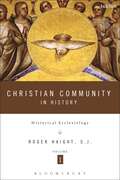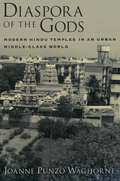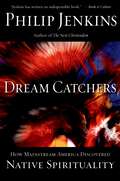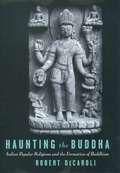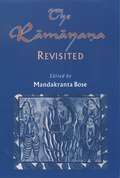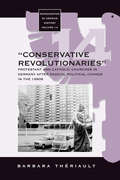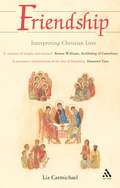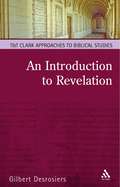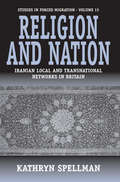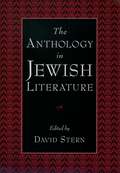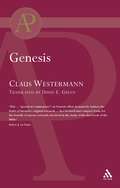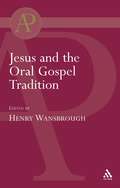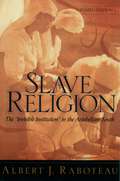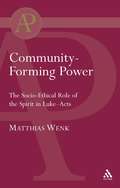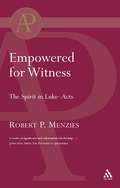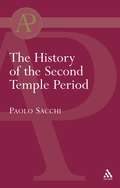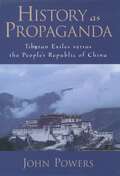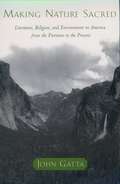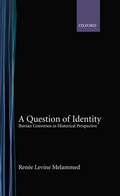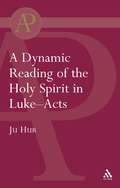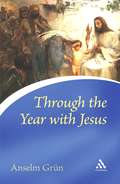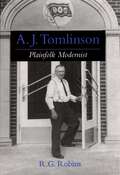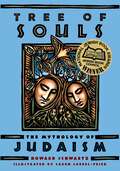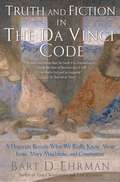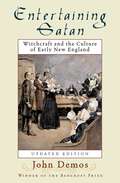- Table View
- List View
Christian Community in History Volume 1: Historical Ecclesiology
by Roger D. HaightDrawing upon the methodology developed in his Dynamics of Theology (1990) and exemplified in Jesus Symbol of God (1999), Roger Haight, in this magisterial work, achieves what he calls an historical ecclesiology, or ecclesiology from below. In contrast to traditional ecclesiology from above, which is abstract, idealist, and ahistorical, ecclesiology from below is concrete, realist, and historically conscious. In this first of two volumes, Haight charts the history of the church's self-understandings from the origins of the church in the Jesus movement to the late Middle Ages. In volume 2 Haight develops a comparative ecclesiology based on the history and diverse theologies of the worldwide Christian movement from the Reformation to the present. While the ultimate focus of the work falls on the structure of the church and its theological self-understanding, it tries to be faithful to the historical, social, and political reality of the church in each period.
Diaspora of the Gods: Modern Hindu Temples in an Urban Middle-Class World
by Joanne Punzo WaghorneMany Hindus today are urban middle-class people with religious values similar to those of their professional counterparts in America and Europe. Just as modern professionals continue to build new churches, synagogues, and now mosques, Hindus are erecting temples to their gods wherever their work and their lives take them. Despite the perceived exoticism of Hindu worship, the daily life-style of these avid temple patrons differs little from their suburban neighbors. Joanne Waghorne leads her readers on a journey through this new middle-class Hindu diaspora, focusing on their efforts to build and support places of worship. She seeks to trace the changing religious sensibilities of the middle classes as written on their temples and on the faces of their gods. She offers detailed comparisons of temples in Chennai (formerly Madras), London, and Washington, D.C., and interviews temple priests, devotees, and patrons. In the process, she illuminates the interrelationships between ritual worship and religious edifices, the rise of the modern world economy, and the ascendancy of the great middle class. The result is a comprehensive portrait of Hinduism as lived today by so many both in India and throughout the world. Lavishly illustrated with professional photographs by Dick Waghorne, this book will appeal to art historians as well as urban anthropologists, scholars of religion, and those interested in diaspora, transnationalism, and trends in contemporary religion. It should be especially appealing for course use because it introduces the modern Hinduism practiced by the friends and neighbors of students in the U.S. and Britain.
Dream Catchers: How Mainstream America Discovered Native Spirituality
by Philip JenkinsIn books such as Mystics and Messiahs, Hidden Gospels, and The Next Christendom, Philip Jenkins has established himself as a leading commentator on religion and society. Now, in Dream Catchers, Jenkins offers a brilliant account of the changing mainstream attitudes towards Native American spirituality, once seen as degraded spectacle, now hailed as New Age salvation. Jenkins charts this remarkable change by highlighting the complex history of white American attitudes towards Native religions, considering everything from the 19th-century American obsession with "Hebrew Indians" and Lost Tribes, to the early 20th-century cult of the Maya as bearers of the wisdom of ancient Atlantis. He looks at the popularity of the Carlos Castaneda books, the writings of Lynn Andrews and Frank Waters, and explores New Age paraphernalia including dream-catchers, crystals, medicine bags, and Native-themed Tarot cards. He also examines the controversial New Age appropriation of Native sacred places and notes that many "white indians" see mainstream society as religiously empty. An engrossing account of our changing attitudes towards Native spirituality, Dream Catchers offers a fascinating introduction to one of the more interesting aspects of contemporary American religion.
Haunting the Buddha: Indian Popular Religions and the Formation of Buddhism
by Robert DeCaroliEarly European histories of India frequently reflected colonialist agendas. The idea that Indian society had declined from an earlier Golden Age helped justify the colonial presence. It was said, for example, that modern Buddhism had fallen away from its original identity as a purely rational philosophy that arose in the mythical 5th-century BCE Golden Age unsullied by the religious and cultural practices that surrounded it. In this book Robert DeCaroli seeks to place the formation of Buddhism in its appropriate social and political contexts. It is necessary, he says, to acknowledge that the monks and nuns who embodied early Buddhist ideals shared many beliefs held by the communities in which they were raised. In becoming members of the monastic society these individuals did not abandon their beliefs in the efficacy and the dangers represented by minor deities and spirits of the dead. Their new faith, however, gave them revolutionary new mechanisms with which to engage those supernatural beings. Drawing on fieldwork, textual, and iconographic evidence, DeCaroli offers a comprehensive view of early Indian spirit-religions and their contributions to Buddhism-the first attempt at such a study since Ananda Coomaraswamy's pioneering work was published in 1928. The result is an important contribution to our understanding of early Indian religion and society, and will be of interest to those in the fields of Buddhist studies, Asian history, art history, and anthropology.
The R-am-aya.na Revisited
by Mandakranta BoseThe Ramayana is one of India's foundational epics, and it demonstrates a continuing power to influence social, religious, cultural, and political life. Brought to textual life in Sanskrit by the legendary "first poet," Valmiki, over the ensuing centuries the tale has been recycled with extraordinary adaptability and diversity through the varied cultural heritages of India and other parts of Asia. The basic tale of the Ramayana is continually adapted to new contexts, forms, and media. It is read, recited, sung, danced, and acted in one form or another, and renewed so constantly by changing times and values that it demands constant revaluation. The Ramayana Revisited presents the latest in Ramayana scholarship. Fourteen leading scholars examine the epic in its myriad contexts throughout South and Southeast Asia. They explore the role the narrative plays in societies as varied as India, Indonesia, Thailand, and Cambodia. The essays also expand the understanding of the "text" to include non-verbal renditions of the epic, with particular attention to the complex ways such retellings change the way the narrative deals with gender. This volume will be invaluable to students and scholars interested in mythology, Hinduism, Asian studies, and anthropology.
The 'Conservative Revolutionaries': The Protestant and Catholic Churches in Germany after Radical Political Change in the 1990s (Monographs in German History #14)
by Barbara TheriaultDuring the forty years of division, the Protestant and Catholic churches in Germany were the only organizations to retain strong ties and organizational structures: they embodied continuity in a country marked by discontinuity. As such, the churches were both expected to undergo smooth and rapid institutional consolidation and undertake an active role in the public realm of the new eastern German states in the 1990s. Yet critical voices were heard over the West German system of church-state relations and the public role it confers on religious organizations, and critics often expressed the idea that despite all their difficulties, something precious was lost in the collapse of the German democratic republic. Against this backdrop, the author delineates the conflicting conceptions of the Protestant and Catholic churches' public role and pays special attention to the East German model, or what is generally termed the "positive experiences of the GDR and the Wende."
Friendship: Interpreting Christian Love
by Liz CarmichaelThe love of friendship has, at the least, established its place as a necessary model of love in Christian tradition. This study shows the deep roots it has in Christian thought, among both ancient and modern writers, and is intended to facilitate further reflection on and exploration of its creative potential now and for the future.
An Introduction to Revelation: A Pathway to Interpretation (T&T Clark Approaches to Biblical Studies)
by Gilbert DesrosiersThe interpretation of the book of Revelation has always aroused controversy, and its use (and abuse) during periods of rapid change has often been a cause for great concern. This volume is intended for students of biblical studies, attempts a responsible reading of Revelation Desrosiers presents the reader with both the tools and the information required to understand the many approaches that may be taken to interpreting the book, and leads the reader toward a sound interpretation.
Religion and Nation: Iranian Local and Transnational Networks in Britain (Forced Migration #15)
by Kathryn SpellmanAn estimated 75,000 Iranians emigrated to Britain after the 1979 revolution and the establishment of the Islamic Republic. They are politically, religiously, socio-economically and ethnically heterogeneous, and have found themselves in the ongoing process of settlement. The aim of this book is to explore facets of this process by examining the ways in which religious traditions and practices have been maintained, negotiated and rejected by Iranians from Muslim backgrounds and how they have served as identity-building vehicles during the course of migration, in relation to the political, economic, and social situation in Iran and Britain. While the ethnographic focus is on Iranians, this book touches on more general questions associated with the process of migration, transnational societies, Diasporas, and religious as well as ethnic minorities.
The Anthology in Jewish Literature
by David SternThe anthology is a ubiquitous presence in Jewish literature--arguably its oldest literary genre, going back to the Bible itself, and including nearly all the canonical texts of Judaism: the Mishnah, the Talmud, classical midrash, and the prayerbook. In the Middle Ages, the anthology became the primary medium in Jewish culture for recording stories, poems, and interpretations of classical texts. In modernity, the genre is transformed into a decisive instrument for cultural retrieval and re-creation, especially in works of the Zionist project and in modern Yiddish and Hebrew literature. No less importantly, the anthology has played an indispensable role in the creation of significant fields of research in Jewish studies, including Hebrew poetry, folklore, and popular culture. This volume is the first book to bring together scholarly and critical essays that investigate the anthological character of these works and what might be called the "anthological habit" in Jewish literary culture--the tendency and proclivity for gathering together discrete, sometimes conflicting traditions and stories, and preserving them side by side as though there were no difference, conflict, or ambiguity between them. Indeed, The Anthology in Jewish Literature is the first book to recognize this habit and genre as one of the formative categories in Jewish literature and to investigate its manifold roles. The seventeen essays, each of which focuses on a specific literary work, many of them the great classics of Jewish tradition, consider such questions as: What are the many types of anthologies? How have anthologists, editors, even printers of anthologies been creative shapers of Jewish tradition and culture? What can we learn from their editorial practices? How have politics, gender, and class figured into the making of anthologies? What determinative role has the anthology played in creating the Jewish canon? How has the anthology served, especially in the modern period, to create and recreate Jewish culture. This landmark volume will interest educated laypersons as well as scholars in all areas of Jewish literature and culture, as well as students of world literature and cultural studies.
Genesis (Academic Paperback Ser.)
by Claus WestermannThe abridged version of Westermann's classic three-volume work on Genesis. This work presents a magisterial commentary in a condensed and more accessible form. Included are a fresh translation of Genesis, the philological reasoning behind the translation, an examination of the historical background of the original text, a survey of all that has been written about Genesis (together with full references) and a consideration of the problems and questions the text of Genesis raises for today.
Jesus and the Oral Gospel Tradition: Jesus And The Oral Gospel Tradition
by Henry WansboroughA collection of papers from two international symposia by such important scholars as Aune, Dunn, Gerhardsson, Meyer, Rordorf and Talmon. The articles share the conviction that the only way to break the deadlock in the Synoptic problem is to examine the oral tradition about Jesus which lay behind the Gospels, and to continue even beyond them. The book addresses such central issues as the characteristics of oral tradition: oral tradition in Judaism, in the teaching of Jesus (his aphorisms and the narrative meshalim) and in the Gospel narratives; and the relationships of John, Paul and the Didache to oral tradition. This volume should bring onto a new plane the discussion of the all-important oral stage of Gospel tradition.
Slave Religion: The "Invisible Institution" in the Antebellum South
by Albert J. RaboteauTwenty-five years after its original publication, Slave Religion remains a classic in the study of African American history and religion. In a new chapter in this anniversary edition, author Albert J. Raboteau reflects upon the origins of the book, the reactions to it over the past twenty-five years, and how he would write it differently today. Using a variety of first and second-hand sources-- some objective, some personal, all riveting-- Raboteau analyzes the transformation of the African religions into evangelical Christianity. He presents the narratives of the slaves themselves, as well as missionary reports, travel accounts, folklore, black autobiographies, and the journals of white observers to describe the day-to-day religious life in the slave communities. Slave Religion is a must-read for anyone wanting a full picture of this "invisible institution."
Community-Forming Power (Academic Paperback Ser.)
by Matthias WenkIn past years the controversy over Luke's concept of the Spirit has centred on the ethical dimension of his pneumatology. Community-Forming Power sets out to address the issue by assessing the Lukan writings in the light of evidence from Second Temple Judaism and in applying speech-act theory to prophetic utterances. Wenk argues that the Spirit's role in prophecy cannot be limited to the content of the prophetic speech, stripping it artificially from the intention behind it. He further argues that the anointed church continues the liberating work of the anointed messiah in embracing the marginalized, and thus is instrumental in 'realizing good news for the poor'.
Empowered for Witness
by Robert MenziesWith this study, Menzies sets a new standard for pneumatology. Beginning with an overview of the pneumatological perspectives of intertestamental Judaism (including literature from the Diaspora, Palestinian, Qumran and rabbinic sources), the first section concludes that for the most part these sources 'consistently identify experience of the Spirit with prophetic inspiration'. The next section aims to uncover Luke's distinctive pneumatology, employing a redaction critical method of analysis in order to illustrate Luke's similarly consistent portrayal of the Spirit as the source of prophetic inspiration, rather than as the source of Christian existence. The final section goes on to explore how this conclusion impacts on contemporary theological reflection and spiritual life. Robert P. Menzies is Lecturer in New Testament at Asia Pacific Theological Seminary, Baguio City, Philippines.
The History of the Second Temple Period (Academic Paperback Ser.)
by Paolo SacchiThis book represents the fruit of a long process of study and reflection, a powerful but subtle synthesis, by one of the most eminent scholars of Second-Temple Judaism. Far from a conventional narrative history, it is organized around themes and seeks to uncover the essence of Hebraic/Jewish religious thinking while confronting the phenomenon of its division into several 'parties' and traditions. Drawing also on recent studies of Christianity as a 'Judaism', Sacchi provides a stimulating perspective on the nature of ancient Oriental and Occidental thought and the intellectual and spiritual heritage of European civilization.
History As Propaganda: Tibetan Exiles versus the People's Republic of China
by John PowersDespite Chinese efforts to stop foreign countries from granting him visas, the Dalai Lama has become one of the most recognizable and best loved people on the planet, drawing enormous crowds wherever he goes. By contrast, China's charismatically-challenged leaders attract crowds of protestors waving Tibetan flags and shouting "Free Tibet!" whenever they visit foreign countries. By now most Westerners probably think they understand the political situation in Tibet. But, John Powers argues, most Western scholars of Tibet evince a bias in favor of one side or the other in this continuing struggle. Some of the most emotionally charged rhetoric, says Powers, is found in studies of Tibetan history. narratives.
Making Nature Sacred: Literature, Religion, and Environment in America from the Puritans to the Present
by John GattaSince colonial times, the sense of encountering an unseen, transcendental Presence within the natural world has been a characteristic motif in American literature and culture. American writers have repeatedly perceived in nature something beyond itself-and beyond themselves. In this book, John Gatta argues that the religious import of American environmental literature has yet to be fully recognized or understood. Whatever their theology, American writers have perennially construed the nonhuman world to be a source, in Rachel Carson's words, of "something that takes us out of ourselves." Making Nature Sacred explores how the quest for "natural revelation" has been pursued through successive phases of American literary and intellectual history. And it shows how the imaginative challenge of "reading" landscapes has been influenced by biblical hermeneutics. Though focused on adaptations of Judeo-Christian religious traditions, it also samples Native American, African American, and Buddhist forms of ecospirituality. It begins with Colonial New England writers such Anne Bradstreet and Jonathan Edwards, re-examines pivotal figures such as Henry Thoreau and John Muir, and takes account of writings by Mary Austin, Rachel Carson, and many others along the way. The book concludes with an assessment of the "spiritual renaissance" underway in current environmental writing, as represented by five noteworthy poets and by authors such as Wendell Berry, Annie Dillard, Marilynne Robinson, Peter Matthiessen, and Barry Lopez. This engaging study should appeal not only to students of literature, but also to those interested in ethics and environmental studies, religious studies, and American cultural history.
A Question of Identity: Iberian Conversos in Historical Perspective
by Renee Levine MelammedIn 1391 many of the Jews of Spain were forced to convert to Christianity, creating a new group whose members would be continually seeking a niche for themselves in society. The question of identity was to play a central role in the lives of these and later converts whether of Spanish or Portuguese heritage, for they could not return to Judaism as long as they remained on the Peninsula, and their place in the Christian world would never be secure. This book considers the history of the Iberian conversos-both those who remained in Spain and Portugal and those who emigrated. Wherever they resided the question of identity was inescapable. The exile who chose France or England, where Jews could not legally reside, was faced with different considerations and options than the converso who chose Holland, a newly formed Protestant country where Jews had not previously resided. Choosing Italy entailed a completely different set of options and dilemmas. Renée Levine Melammed compares and contrasts the lives of the New Christians of the Iberian Peninsula with those of these countries and the development of their identity and sense of ethnic solidarity with "those of the Nation." Exploring the knotty problem of identity she examines a great variety of individual choices and behaviors. Some conversos tried to be sincere Catholics and were not allowed to do so. Others tried but failed either theologically or culturally. While many eventually opted to form Jewish communities outside the Peninsula, others were unable to make a total commitment to Judaism and became "cultural commuters" who could and did move back and forth between two worlds whereas others had "fuzzy" or attenuated Jewish identities. In addition, the encounter with modernity by the descendants of conversos is examined in three communities, Majorca, Belmonte (Portugal) and the Southwestern United States, revealing that even today the question of identity is still a pressing issue. Offering the only broad historical survey of this fascinating and complex group of migrants, this book will appeal to a wide range of academic and general readers.
Dynamic Reading of the Holy Spirit in Luke-Acts (The Library of New Testament Studies #211)
by Ju HurJudging by the number of references to Holy Ghost in Luke's gospel and Acts, it is no wonder that Luke is designated as the "enthusiast in/for the Spirit†? or that the Acts of the Apostles is called "the Acts of the Holy Spirit.†? The Holy Spirit has also been one of the most constantly debated subjects among the many issues concerning Luke and/or Acts. This study will re-visit the topic of the Holy Spirit in Luke-Acts through a new perspective. Part of this volume discusses three contemporary understandings of Lukan pneumatology; that of J. D. G. Dunn, R. P. Menzies and M. M. B. Turner. These reflect three different positions in regard to this subject.
Through the Year with Jesus (Continuum Icons)
by Anselm GrünHere is an entirely fresh and original book about Jesus, the Jesus of devotion, the Jesus within.Here are fifty pictures (or images) of Jesus, each being a chapter of the book. We need to get away from cliches and see what Jesus really means for people today. After a brief account of Jesus and his times, the author introduces the book and how to read it. Some of the pictures of Jesus are surprising- Jesus the drop out, the vagabond, the one who refuses power,the family therapist and the exorcist.Gruen has a rare gift of simple communication, of bringing Jesus alive to modern men and women.This was a gift which Henri Nouwen also had and the publishers are expecting to command similar sales.The style is simple and direct and psychologically in tune with our times.
A. J. Tomlinson: Plainfolk Modernist (Religion in America)
by R. G. RobinsA.J. Tomlinson (1865-1943) ranks among the leading figures of the early Pentecostal movement, and like so many of his cohorts, he was as complex as he was colorful. Arriving in Appalachia as a home missionary determined to uplift and evangelize poor mountain whites, he stayed to become the co-founder and chief architect of the Church of God (Cleveland, TN) and the Church of God of Prophecy, which together with their minor offspring now constitute the third-largest denominational family within American Pentecostalism. R.G. Robins's biography recreates the world in which Tomlinson operated, and through his story offers a new understanding of the origins of the Pentecostal movement. Scholars have tended to view Pentecostalism as merely one among many anti-modernist movements of the early twentieth century. Robins argues that this is a misreading of the movement's origins-the result of projecting the modernist/fundamentalist controversy of the 1920s back onto the earlier religious landscape. Seeking to return the story of Pentecostalism to its proper historical context, Robins suggests that Pentecostalism should rightly be seen as an outgrowth of the radical holiness movement of the late nineteenth century. He argues that, far from being anti-modern, Pentecostals tended to embrace modernity. Pentecostal modernism, however, was a working class or "plainfolk" phenomenon, and it is the plainfolk character of the movement that has led so many scholars to mislabel it as anti-modern or fundamentalist. Through the compelling narrative of Tomlinson's life story, Robins sheds new light on late-nineteenth and early-twentieth century American religion, and provides a more refined lens through which to view the religious dynamics of our own day. v
Tree of Souls: The Mythology of Judaism
by Howard SchwartzThe first anthology of Jewish mythology in English, Tree of Souls reveals a mythical tradition as rich and as fascinating as any in the world. Drawing from the Bible, the Pseudepigrapha, the Talmud and Midrash, the kabbalistic literature, medieval folklore, Hasidic texts, and oral lore collected in the modern era, Schwartz has gathered together nearly 700 of the key Jewish myths. The myths themselves are marvelous. We read of Adams diamond and the Land of Eretz (where it is always dark), the fall of Lucifer and the quarrel of the sun and the moon, the Treasury of Souls and the Divine Chariot. We discover new tales about the great figures of the Hebrew Bible, from Adam to Moses; stories about God's Bride, the Shekhinah, and the evil temptress, Lilith; plus many tales about angels and demons, spirits and vampires, giant beasts and the Golem. Equally important, Schwartz provides a wealth of additional information. For each myth, he includes extensive commentary, revealing the source of the myth and explaining how it relates to other Jewish myths as well as to world literature (for instance, comparing Eves release of evil into the world with Pandoras). For ease of use, Schwartz divides the volume into ten books, Myths of God, Myths of Creation, Myths of Heaven, Myths of Hell, Myths of the Holy Word, Myths of the Holy Time, Myths of the Holy People, Myths of the Holy Land, Myths of Exile, and Myths of the Messiah.
Truth and Fiction in The Da Vinci Code: A Historian Reveals What We Really Know about Jesus, Mary Magdalene, and Constantine
by Bart D. EhrmanIn his staggeringly popular work of fiction, Dan Brown states up front that the historical information in the The Da Vinci Code is all factually accurate. But is this claim true? As historian Bart D. Ehrman shows in this informative and witty book, The Da Vinci Code is filled with numerous historical mistakes. Did the ancient church engage in a cover-up to make the man Jesus into a divine figure? Did Emperor Constantine select for the New Testament--from some 80 contending Gospels--the only four Gospels that stressed that Jesus was divine? Was Jesus Christ married to Mary Magdalene? Did the Church suppress Gospels that told the secret of their marriage? Bart Ehrman thoroughly debunks all of these claims. But the book is not merely a laundry list of Brown's misreading of history. Throughout, Ehrman offers a wealth of fascinating background information--all historically accurate--on early Christianity. He describes, for instance, the discovery of the Dead Sea Scrolls ; outlines in simple terms how scholars of early Christianity determine which sources are most reliable; and explores the many other Gospels that have been found in the last half century. In his engaging book, Ehrman separates fact from fiction, the historical realities from the flights of literary fancy. Anyone who would like to know the truth about the beginnings of Christianity and the real truth behind The Da Vinci Code will find this book riveting.
Entertaining Satan: Witchcraft and the Culture of Early New England
by John Putnam DemosIn the first edition of the Bancroft Prize-winning Entertaining Satan, John Putnam Demos presented an entirely new perspective on American witchcraft. By investigating the surviving historical documents of over a hundred actual witchcraft cases, he vividly recreated the world of New England during the witchcraft trials and brought to light fascinating information on the role of witchcraft in early American culture. Now Demos has revisited his original work and updated it to illustrate why these early Americans' strange views on witchcraft still matter to us today. He provides a new preface that puts forth a broader overview of witchcraft and looks at its place around the world--from ancient times right up to the present.
